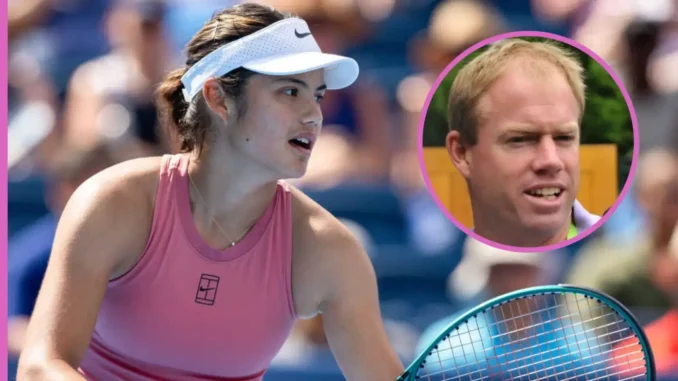
Emma Raducanu, the 22-year-old British tennis sensation, has long been a symbol of prodigious talent and unfulfilled promise on the global stage. Four years after her stunning victory at the US Open in 2021, where she captured the hearts of fans worldwide as an 18-year-old qualifier, Raducanu finds herself navigating a challenging path back to the summit. Her latest setback came in the third round of this year’s US Open, a tournament that once crowned her a champion but now exposed the hurdles she must overcome. Facing ninth seed Elena Rybakina, Raducanu was outpowered in straight sets, 6-1, 6-2, as the Kazakh player’s blistering serves and aggressive groundstrokes overwhelmed her. It was a stark reminder of the evolution in women’s tennis, where raw power often dictates the outcome.
Since that fairy-tale win in New York, Raducanu’s career has been a rollercoaster of highs and inconsistencies. Injuries, coaching changes, and the immense pressure of expectations have tested her resilience. This season alone, she showed flashes of her potential by reaching the third round at the Australian Open, Wimbledon, and the US Open—her best major results of the year, excluding a first-round exit at the French Open. Her standout moment came at Wimbledon 2024, where she advanced to the fourth round, proving she could still compete at the elite level. Yet, for every breakthrough, there’s been a stumble, like the recent defeat to Rybakina, who went on to face top seed Aryna Sabalenka in the final—a matchup that underscored the dominance of the tour’s heavy hitters.
Enter Mark Petchey, Raducanu’s former interim coach who worked with her earlier this year during a transitional period. Petchey, a respected figure in British tennis with his own playing background, has been candid about the road ahead for his ex-protégé. Speaking reflectively on her style and prospects, he emphasized that reclaiming Grand Slam glory won’t come without significant adaptation. “It won’t be easy,” Petchey acknowledged, highlighting the shift in the sport toward players who unleash ferocious pace from the baseline. He pointed to the likes of Sabalenka and Amanda Anisimova as exemplars of this trend, noting how their shots rush opponents and disrupt rhythm. For Raducanu, whose game thrives on precision and redirection rather than brute force, this presents a unique challenge.
Petchey delved deeper into what makes Raducanu tick on the court. Her optimal approach, he explained, involves staying aggressive at the baseline, “redirecting the ball, moving it around, trying to get the opponent to move before they get a chance to set on the ball.” It’s a cerebral, athletic style that played to her strengths in 2021, allowing her to outmaneuver bigger opponents with footwork and angles. But in today’s game, where power players like Rybakina can dictate with aces and winners, Raducanu must evolve. “That’s obviously something that she’s going to have to keep getting better at,” Petchey stressed. He was pragmatic about her physical limitations too— at 5-foot-9, she can’t suddenly grow taller to match the serving dominance of someone like Rybakina. “She can’t get taller; she’s not going to suddenly have a Rybakina serve that’s going to get her as many free points,” he said. Instead, the focus should be on refining her serve for greater accuracy, which could set up her baseline rallies more effectively and yield crucial points over time.
The US Open loss, in Petchey’s view, was a microcosm of these battles. “What it said to me is everything that I hope people can see about Emma’s style of play,” he reflected. “We’re in an era of big hitters—we talk about the pace of shots, from both Sabalenka and Anisimova. These power players that make life difficult for Emma where they do rush her and are going to make things tricky.” Yet, he sees it not as a defeat, but as fuel. “But it’s one of those matches which just goes to show you know that it’s not going to be easy to win another major. But that’s what’s going to be so satisfying when she finally does.” For Raducanu, who has cycled through coaches in search of stability—including a recent hire of Francisco Roig, Rafael Nadal’s longtime mentor, for the US Open—these insights from Petchey offer a roadmap. Their interim partnership earlier in the year focused on shoring up key elements of her game, and while it ended amicably, his belief in her potential remains unshaken.
Looking ahead, Raducanu’s journey is far from over. She’s received a wildcard into the Korea Open in Seoul next week, a chance to regroup on the hard courts of Asia and build momentum before the Asian swing intensifies. Notably, she’s opted out of Great Britain’s Billie Jean King Cup finals in China, prioritizing her individual recovery and preparation. At just 22, with a US Open title already under her belt, Raducanu has time on her side. Her story is one of perseverance in a sport that rewards not just talent, but tactical evolution. As Petchey put it, the very difficulties posed by the big hitters serve as “just motivation for her to keep working on the things that she has been doing.” If she can refine her baseline mastery and serve precision, the satisfaction of another major triumph could indeed be within reach, reigniting the spark that made her a global icon. In the unforgiving world of professional tennis, Raducanu’s next chapter promises to be as compelling as her first.
Leave a Reply